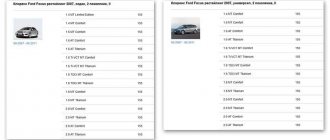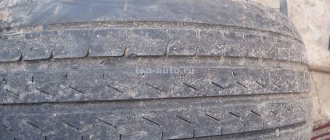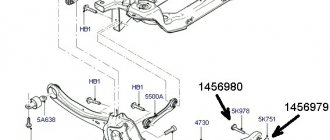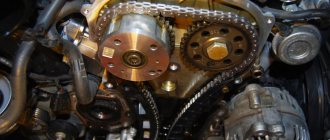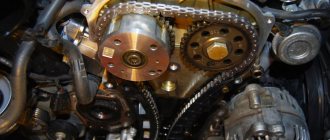Ford Focus is a compact car from an American manufacturer that is very popular in our market. The brand has become famous for its technology, which has proven itself from the best side. The second generation Ford Focus was the most popular car in Russia in 2003-2008. A distinctive feature was the low price, good driving characteristics and reliable power plants. The 1.6-liter Ford Focus 2 engine was produced in two versions, with a power of 100 and 115 hp. This is the same engine, only set to 115 hp. It has a Ti-VCT valve timing control system, which results in greater power. Engine 1.6 100 hp from the Duratec series (or according to another Zetec-SE specification) has a twin brother, but with a volume of 1.4 liters. Structurally, Duratec 1.6 and Duratec 1.4 are almost identical, so this article will also be of interest to owners of the 1.4 liter engine. The only difference is the size and stroke of the piston, different connecting rods and crankshaft. And these are naturally aspirated 16-valve gasoline engines with an aluminum cylinder block and a timing belt. Focuses produced in Russia were equipped with a Duratec 16V Sigma (Zetec-S) 1.6 liter engine. 100 hp. The power unit turned out to be the most popular on the Ford Focus 2.
Engine design Ford Focus 2 1.6
Engine Focus 2 1.6 liters with a power of 100 horsepower - gasoline, four-stroke, four-cylinder, in-line, sixteen valves, with two camshafts. The location in the engine compartment is transverse. The operating order of the cylinders is: 1–3–4–2, counting from the auxiliary drive pulley. The power supply system
is phased distributed fuel injection (Euro-4 toxicity standards). The engine, gearbox and clutch form the power unit - a single unit mounted in the engine compartment on three elastic rubber-metal supports. The right support is attached to a bracket located on the right wall of the cylinder block, and the left and rear ones are attached to the gearbox housings.
The Ford Focus 2 Duratec 1.6
cylinder block At the bottom of the cylinder block there are crankshaft supports - five beds of the main shaft bearings with a plate (removable cover) common to all beds, which is attached to the block with ten bolts. The main bearings of the crankshaft are processed together with the plate. crankshaft
is made of high-strength cast iron, with five main and four connecting rod journals. The shaft is equipped with eight counterweights, made along the continuation of its “cheeks”. Counterweights are designed to balance the forces and moments of inertia that arise during the movement of the crank mechanism during engine operation. The crankshaft main and connecting rod bearing shells are steel, thin-walled, with anti-friction coating.
The main and connecting
rod journals of the crankshaft connect channels drilled in the shaft body, which serve not only to supply engine oil from the main to the connecting rod bearings, but also to centrifugally clean the oil from solid particles and deposits when the shaft rotates.
At the front end (toe) of the crankshaft are installed: a timing gear drive gear pulley and an auxiliary drive pulley. Oil pump
. The Ford Focus 2 engine has a combined lubrication system. Oil is supplied to the parts of the power plant under pressure pumped by an oil pump. The pump design has internal gears and a pressure reducing valve. The pump is driven by a drive gear mounted on the toe of the crankshaft. The oil is taken from the sump by the pump and, passing through the oil filter, enters the main line of the cylinder block. From there it flows through the oil channels to the bearings of the crankshaft and camshaft.
The cylinder head
is made of aluminum alloy. The valves in the cylinder head are arranged in two rows, V-shaped, with two intake and two exhaust valves for each cylinder. The valves are steel, the exhaust valves have a plate made of heat-resistant steel and a welded bevel. The diameter of the intake valve disc is larger than that of the exhaust valve. Valve seats and guides are pressed into the cylinder head. On top of the valve guides are valve stem seals made of oil-resistant rubber. The valve closes under the action of a spring. Its lower end rests on the washer, and its upper end rests on a plate held by two crackers. The crackers folded together have the shape of a truncated cone, and on their inner surface there are beads that fit into the grooves on the valve stem.
Design features of Ford QQDB
The Duratec-HE gasoline engine is equipped with a DOHC gas distribution system typical for this type of installation, which has a special camshaft design. This internal combustion engine configuration uses a reliable timing drive operating according to a chain transmission scheme. This feature allows us to guarantee an increased service life and ease of operation. To find the engine number, look at the left side of the rear of the cylinder block.
The QQDB engine has an electronic fuel injection system and develops power up to 125 hp. With. High-strength aluminum alloy is used as the material for the cylinder block. Moreover, the cylinder head and pan are also made of aluminum, which ensures a relatively light weight of the power plant. The Duratec-HE engine is a 4-cylinder unit with a 16-valve system.
Timing drive for Ford Focus 2 1.6 engine
The camshafts are driven by a toothed belt from the crankshaft pulley. An automatic tensioner ensures the required belt tension during operation. A feature of the gas distribution mechanism drive is that the toothed pulleys of the crankshaft and camshafts are not fixed to the shafts using keys or pins, but only due to the friction forces that arise on the end surfaces of the pulleys and shafts when the pulley mounting bolts are tightened. Timing drive diagram for Ford Focus 2 1.6 in the photo just above. On this engine, when the timing belt breaks, the valve bends, so it is better not to delay replacement. According to the regulations, replacing the timing belt on a Focus 2 1.6 16 valves is carried out once every 100,000 kilometers.
Maintenance periods for main components
Engine problems for a Ford car, although quite rare, can arise due to various circumstances. According to the data specified in the operating manual, this type of engine will not cause problems for 350 thousand kilometers. Practice shows much better potential of the engine, and in most cases, Ford QQDB easily overcomes the 500 thousand kilometer mark without the need for repairs. However, such indicators require compliance with all maintenance periods, and the following standards should be met:
- Valves on internal combustion engines are adjusted after 150 thousand km;
- The timing chain resource does not exceed 200 thousand km;
- Air filter - after 15 thousand km.
Specifications
The more powerful engine has the same design as the 1.6 100 hp engine; a distinctive feature is the presence of a variable valve timing system.
| Power plant model | Ford Focus 2 1.6 (100hp) | Ford Focus 2 1.6 (115hp) |
| Engine capacity, cm3 | 1595 | 1595 |
| Number of cylinders/valves, pcs. | 4/16 | 4/16 |
| Cylinder, diameter, mm | 79,0 | 79,0 |
| Piston, stroke, mm | 81,4 | 81,4 |
| Power, horsepower | 100 | 115 |
| Torque moment, Nm | 145 | 155 |
| Compression | 11 | 11 |
| Timing drive | belt (DOHC) | belt (DOHC) |
| Fuel type | gasoline, AI-95 | gasoline, AI-95 |
| Consumption, liter/100 km (city/highway/mixed) | 8,7/5,5/6,7 | 8,7/5,1/6,4 |
| Cylinder block, material | aluminum | aluminum |
| Environmental Compliance | Euro – 4 | Euro – 4 |
| Engine life, km | 250000 | 250000 |
| Weight of the power plant, kg. | 90 | 90 |
The engine was installed on:
Ford C-Max Ford Fiesta Mk.IV Ford Fiesta Mk.V Ford Focus Mk. I Ford Focus Mk. II Ford Fusion Ford Mondeo Mk IV Ford Puma Mazda 2 Mk.II Volvo C30 Volvo S40 Mk.II
Malfunctions and repairs of the Duratec 1.6 engine
Engine Ford Focus Duratec 1.6 l. produced since 1998, in 2004 it was renamed from Zetec to Duratec, the torque increased from 145 Nm to 150 Nm, at the same time, the engine was strangled to meet the Euro-4 environmental standard and underwent other, minor and insignificant for the average owner, changes . The motors date back to 1995 and were developed with the help of the Japanese company Yamaha. The service life of the Ford Focus 1.6 engine is 250 thousand km according to the plant; according to reports from car enthusiasts, 300-350 thousand go without problems. It is difficult to note any technical shortcomings of the engine; the engine is very successful, reliable and not capricious. Its main disadvantage is its low power, for example, the most popular and mass-produced car, the Ford Focus II, with such an engine does not drive at all, especially with an automatic transmission. In order for the engine to serve for a long time and not create problems for the owner, it must be done every 60 thousand km. Changing the rollers and timing belt will not require a lot of money. Let's talk about possible malfunctions of your Duratek 1.6, like its 1.4 liter brother, the engine can occasionally (!) trip, vibrate, get hot, knock, make noise, etc. The engine is very good and reliable, there is a version with adjustable valve timing Ti-VCT 1.6 liters, but lovers of active driving should avoid both of them; for such cases, there is an even more reliable and affordable aftermarket 2.0 145 horsepower engine.
Engine tuning Ford Focus 1.6 100 hp
Chip tuning Duratec 1.6
.
The first thing that comes to the owners' mind is to flash it, in the hope that the car will perform like a 2.5 liter ST. Usually, after the firmware, your 1.6 will produce about 110-115 hp, in practice the increase is quite insignificant and is more of a self-hypnosis nature, while fuel consumption will increase. It’s up to you to decide whether to do it or not, essentially it’s money for nothing, let’s move on to the next point. Installing a compressor on Duratec 1.6
.
Just like on the 1.4 liter engine, on the 1.6 you can also install a ready-made kit on the PC-23-1, which is very popular among tuning cans. The operating pressure of the compressor is 0.5 bar and its peculiarity is the ability to install it on a standard Duratek motor, without reducing the compression ratio in the shortest possible time (several hours). According to the manufacturer, the increase in power ranges from 30 to 50%; in terms of dynamic performance, the car will be close to those with a Duratec HE 2.0 liter engine. In quiet mode, with periodic accelerations and timely maintenance of the compressor, the car will not disappoint you. Installing a more powerful compressor or turbine at Focus 1.6 on a standard engine will end sadly, and with the modification of the ShPG, the budget increases significantly. Installation 2.0 l.
for 1.6 liter focus . The ideal tuning of a 1.6 liter engine is to replace it with a 2.0, higher power, even greater reliability and service life. At the same time, fuel consumption remains at the same level or increases slightly.
Duratec or Sigma
1.6 Duratec Ti VCT
is an improved version of
1.6 Duratec
and differs from it in the presence of phase shifters, an intake manifold and the presence of grooves on the surface of the pistons.
But in fact, it is very easy for the average person to get confused in the names proposed by Ford - the Duratec
hides the
Sigma family.
This line dates back to the 90s: the first representatives of the family with a volume of 1.25 liters.
and
1.4 l.
were manufactured for Fiesta, with the advent of the first Focus, a
1.6 liter engine was launched into production.
, well, with the advent of the second generation Focus, a version with phase shifters appeared, now referred to as
1.6 Duratec Ti VCT.
Japanese companies such as Yamaha and Mazda
, thanks to this close cooperation,
Mazda 3 and Ford Focus 2 became co-platforms.

